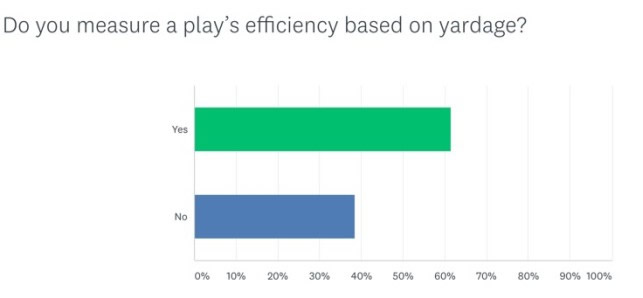By Mike Kuchar
Senior Research Manager/Co-Founder
X&O Labs
Twitter: @MikekKuchar
After working with Coach Longo on this project, I felt compelled to provide a translation for high school coaches on how to take some of these same principles and gear them to their own game planning method. As an offensive coordinator myself, it opened up my eyes to new ways of game planning. I thought back to this season, how many times I called might have called a bad play, particularly in big spots. It still haunts me six months later.
So, my plan was to take the same model that Coach Longo used and apply it to the high school coach. Many of us don’t have the same resources he does, like the use of two graduate assistants and Pro Football Focus, but I found there are ways to adapt some of these principles for game planning around our systems. There is an extensive amount of information in the previous courses of this study so I segmented our research into seven key tenets that can be adapted into any game planning process.
In order to gauge how coaches were conducting game planning, we conducted some pre-research by sending out a survey to all of the offensive coordinators in our network. Over 500 coaches responded and the results were what we figured - coaches are spending too much time changing their systems from one week to the next in preparing for their opponents.
Tenet 1—Less is Always More: Streamline Your Play Menu
We found that 60% of coaches still choose to carry over 20 or more concepts into their offensive game week preparations. Consider this: according to HUDL, the average number of high school offensive plays per game is 72. This means that each play can barely be run four times during the course of a game if you’re going to use all of the concepts on your play menu that week. If the argument is in most cases offensive coordinators will not use all of the plays in the menu, our simple rebuttal would be: then why include them in the menu?
Sounds simple enough, right? But this may be a struggle for some offensive coordinators like myself. We love everything. We see it, we take it, we implement it and off we go. I get it and so does Coach Longo. But Coach Longo is hell-bent on having no more than twenty concepts in his playlist that week and self-admits using “repeaters” between 8-10 times a game. As coaches we all know that the less you do, the better you get at it. Yet, it’s a constant struggle to keep your play menu limited.
How many times have you seen the quarterback get to the line of scrimmage only to realize that you're in the wrong play call? While I realize that many coaches are giving their QB’s “outs” by building relief throws into concepts, the difference with Coach Longo’s system is that he builds universal concepts into his play call. He has concepts that can be effective against any coverage. We all can do this by breaking down our game planning by packaging concepts based in thirds: the right perimeter, run box and left the perimeter.
Tenet 2—What Is Your 95%? Defining Efficiency
61% of coaches still use yardage to define a play’s efficiency. But there are so many factors… down and distance, field position, etc. that go into why a play was efficient and why it may not be efficient. As Coach Longo told us, to tag an arbitrary number (based on an average of total plays and yards gained) doesn't correctly measure whether a play was efficient for those particular circumstances. Yet why are so many coaches still relying on yards gained to determine if a play was effective or not?

Coach Longo talked in great length about designing his game plan around concepts that have a projected 95% efficiency rating. But how do you measure efficiency? For years, I’ve heard coaches use four yards per play as the gold standard for a play’s efficiency. Do the math and it’s a simple solution to gain first downs. Yet, according to HUDL’s 2019 performance report, the average yards per play gains 6.01 yards nationally. So, what measures efficiency in your program? While Coach Longo adheres to the four yards per play declaration in the run game, pass game efficiency is completely reliant on the individual pass routes in the concept. A dig is 8 yards, a drop back vertical is 12 yards, etc. It’s all based on where the ball is being thrown.
While there are numerous factors that tie into efficiency- all of which we explain in the report- I think it’s important for coaches to generate an efficiency plan before the season for each of their play concepts. Not only does it provide for realistic expectations for players and coaches but can also serve as the basis for eliminating or keeping plays during the offseason review.









